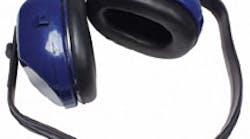Not many supervisors encourage employees to tune them out, but that's exactly what many electrical contractors do when they provide hearing protection devices (HPDs) for their workers. While protecting ears from dangerous noise levels is vital in many environments, the HPDs that block the most sound may also impede communication and warning signal detection.
Rick Neitzel, director of communications for the National Hearing Conservation Association (NHCA), Greenwood Village, Colo., conducts workplace health and safety research, focusing mostly on noise and hearing loss. He says many new HPDs focus less on offering the maximum possible hearing protection and more on providing the right type and level of protection.
“One of the primary reasons that people complain about and ultimately don't use hearing protectors is that they interfere with communication in some cases,” Neitzel says. “These new protectors are designed to let through speech frequencies a little better — or in some cases just block a little less sound — and ultimately enable people to communicate more easily.”
Many earplugs and earmuffs block out most high-frequency noise, but have trouble filtering out low-frequency sounds. This makes speech difficult to understand. But some newer devices block out low and high frequencies at essentially equal levels, which creates what is called a “flat” attenuation. “You can hear high frequencies like speech and other sounds more clearly, and not have as much distortion due to the hearing protector,” Neitzel says.
The following list outlines some new HPD technologies available on the market today:
Amplification earmuffs. These earmuffs are designed to amplify normal sounds to a safe level while still protecting the ears from dangerously loud noises. “Once the sound drops below typically about 82dB, the muffs start to amplify things,” Neitzel says. “So you can communicate comfortably with people and not have to remove the hearing protectors.”
Two-sided earplugs. These earplugs can be placed in the ears one way to protect against sustained high-level noise, or flipped around and placed in the ear the opposite way to allow most sound to pass through — except for very brief high-level noises, such as gun shots. “On a construction site where you might have noises that happen unexpectedly and are very short, you might put the protector in one way, versus if you're going to be driving a bulldozer all day,” Neitzel says.
Push-to-listen earmuffs. “Essentially it's just a regular old earmuff, but if you want to communicate with somebody and let a little bit more sound in for short periods to have a brief conversation, you press a button, and that activates a microphone in the earmuff that channels in the speech for a period of 20 or 30 seconds,” Neitzel says. “Then it just goes back to being a regular earmuff.”
Ultimately, Neitzel says it is important to provide a variety of HPDs to employees so that the protection type and level is appropriate for the task at hand.



